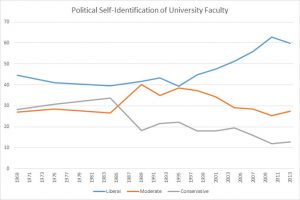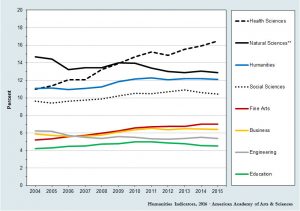University faculty ranks have long been thought of as bastions of the political left, and with good reason: sizable majorities of professors self-identify as modern liberal or left-leaning in their politics. This trend dates back to the first comprehensive faculty survey on political leanings in 1969.
The leftward tilt of college professors used to be more static than it is today. Between 1969 and 1998, self-identified liberals consistently made up between 40 and 45% of faculty in American colleges and universities, but they did not waver much from this range. While these totals outnumbered conservatives and moderates, all three groups were relatively stable in size. In fact, several academic studies published between the 1970s and 1990s pointed to this stable pattern as evidence that long-running conservative grievances about “faculty bias” were overblown.
Then something changed.
Starting in the mid-1990s, the number of college professors who self-identified as conservatives or even moderates began to rapidly decline. In 1998, moderates made up 37% of the academy and conservatives made up 18%. In the most recent survey from 2013, moderates and conservatives dropped to 27% and 12% respectively. Meanwhile, self-identified liberals exploded in number. They sat at 45% in 1998, and have grown to 60% in the most recent survey. That’s a shift of over 15 percentage points away from conservatives and moderates and toward self-identified liberals.
The chart below depicts this trend using the Higher Education Research Institute (HERI) faculty survey (1989-present) combined with its predecessor, the Carnegie Commission Higher Education Survey (1969, 1975, 1984). The once-disputed leftward shift in academia is now unambiguously attested in recent data.

But why has this shift occurred after several decades of stability? By turning to other measures we may catch a glimpse of the answer. It has to do with faculty composition, as well acute leftward biases in specific academic disciplines.
As a recent article by political scientist Sam Abrams documented, some disciplines skew substantially further to the left than academia as a whole. While roughly 60% of all professors self-identify as liberals, that number tops 80% among English professors. History, political science, fine arts, and the other humanities and social sciences are all substantially more liberal than the academy as a whole. They have also shifted further left with the overall trends seen in the chart above.
The leftward skew of the humanities, fine arts, and social sciences matters because these disciplines have also exhibited faster growth in faculty employment than the rest of academia, despite having notoriously saturated job markets in many cases (note that job market saturation does not mean the total number of humanities jobs are declining – it means that the number humanities job seekers continues to outpace the growth in humanities jobs).
We can see this pattern in a second chart from the American Academy of Arts and Sciences, depicting the percentage of university faculty who work in each academic field:
By taking a closer look at the trend lines, we may see how left-leaning areas of the academy have grown faster than the rest in the past decade. For our purposes, set aside the dashed line representing “Health Sciences,” which is actually a result of the boom in nursing and other healthcare professional degrees in recent years.
Among the remaining disciplines, the biggest gains in faculty shares are fine arts (1.82 percentage points), humanities (1.01), and social sciences (0.83). By comparison, the two biggest declines in percentage points were the natural sciences (-1.79) and engineering (-0.87).
The pattern becomes even more visible when we group together all of the disciplines that skew further to the left of the academy. Humanities, fine arts, and social science faculty all lean further left than academia as a whole. Jointly, they posted a 3.66 percentage point gain in their overall share of faculty. When combined together, the much-discussed STEM disciplines lost 2.65 percentage points from their early 2000s faculty share over the last decade. Note that while self-identified liberals are still the largest group within the STEM discipline faculty as well, they tend to be less left-leaning than faculty as a whole.
What this basically means is that the most politically skewed disciplines – the humanities, fine arts, and social sciences – have grown their faculty at a faster rate than other less politicized disciplines. This skewed growth pattern has increased their footprint on campus relative to other faculty, and it has done so at a time of an additional leftward shift in their own ranks. The cumulative effect is to pull the university system as a whole even further to the left, yielding the overall pattern we have seen in the faculty survey at a time when the American public at large has maintained a fairly stable liberal/conservative divide.
